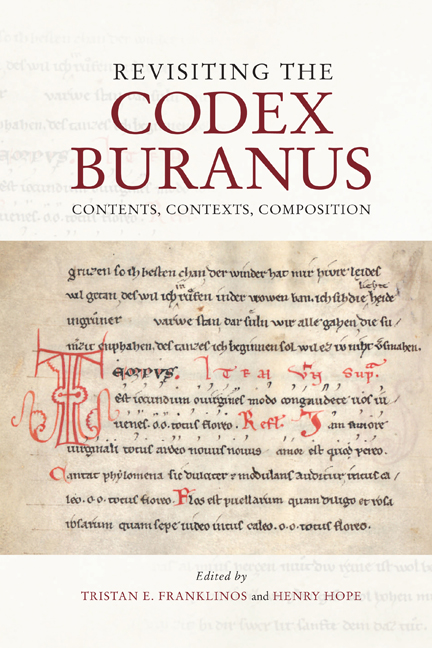Book contents
- Frontmatter
- Contents
- List of Illustrations
- Acknowledgements
- Abbreviations
- Dedication
- Introduction: The Codex Buranus – A Unique Challenge
- Chapter 1 A Modern Reception History of the Codex Buranus in Image and Sound
- Chapter 2 Parody in the Codex Buranus
- Chapter 3 Satire in the Codex Buranus
- Chapter 4 ‘Artes Amatorie Iam Non Instruuntur’: Learned and Erotic Discourse in the Carmina Burana
- Chapter 5 Classical Learning and Audience in the Carmina Amatoria: A Case-Study on CB 92
- Chapter 6 Rape, the Pastourelle, and the Female Voice in CB 185
- Chapter 7 Rethinking the Carmina Burana III: The Poetry of Peasants
- Chapter 8 Predestination and God’s Grace: The Salvific Architecture of the Religious Songs in the Codex Buranus
- Chapter 9 Revisiting the Plays of the Codex Buranus
- Chapter 10 Revisiting the Music of the Codex Buranus
- Chapter 11 Locating the Codex Buranus: Notational Contexts
- Chapter 12 Plurilingualism in the Codex Buranus: An Intercultural Reconsideration
- Chapter 13 Compilation, Contrafacture, Composition: Revisiting the German Texts of the Codex Buranus
- Afterword: multiformis armonia, scolaris symphonia
- List of Manuscripts
- Bibliography
- Index
- General Index
- Studies in Medieval and Renaissance Music
Chapter 8 - Predestination and God’s Grace: The Salvific Architecture of the Religious Songs in the Codex Buranus
Published online by Cambridge University Press: 16 September 2020
- Frontmatter
- Contents
- List of Illustrations
- Acknowledgements
- Abbreviations
- Dedication
- Introduction: The Codex Buranus – A Unique Challenge
- Chapter 1 A Modern Reception History of the Codex Buranus in Image and Sound
- Chapter 2 Parody in the Codex Buranus
- Chapter 3 Satire in the Codex Buranus
- Chapter 4 ‘Artes Amatorie Iam Non Instruuntur’: Learned and Erotic Discourse in the Carmina Burana
- Chapter 5 Classical Learning and Audience in the Carmina Amatoria: A Case-Study on CB 92
- Chapter 6 Rape, the Pastourelle, and the Female Voice in CB 185
- Chapter 7 Rethinking the Carmina Burana III: The Poetry of Peasants
- Chapter 8 Predestination and God’s Grace: The Salvific Architecture of the Religious Songs in the Codex Buranus
- Chapter 9 Revisiting the Plays of the Codex Buranus
- Chapter 10 Revisiting the Music of the Codex Buranus
- Chapter 11 Locating the Codex Buranus: Notational Contexts
- Chapter 12 Plurilingualism in the Codex Buranus: An Intercultural Reconsideration
- Chapter 13 Compilation, Contrafacture, Composition: Revisiting the German Texts of the Codex Buranus
- Afterword: multiformis armonia, scolaris symphonia
- List of Manuscripts
- Bibliography
- Index
- General Index
- Studies in Medieval and Renaissance Music
Summary
The Codex Buranus arguably stands out from the common medieval practice of gathering together collections of religious texts because of its non-religious content. The classical divisions proposed by modern editors suggest that, beyond the concluding section of religious plays, the collection does not include a distinct group of religious texts. The seemingly counter-intuitive decision to dedicate a chapter to religious poetry in the current volume, however, underlines the complex relationship between the manuscript's undoubtedly religious production context and the songs’ function or use, which extends beyond the merely religious. Although modern editors have refrained from subdividing the so-called moral-satirical songs – the section from CB 1 to CB 55 – by allowing for a subsection on religious poetry, more than half of these songs focus on religion. There is no doubt that the religious sphere – as the word ‘sphere’ already suggests – is all-encompassing in the Codex Buranus; and yet, the religious content is scarcely highlighted in scholarship. The present chapter tackles this desideratum by investigating the understanding of religion portrayed by the texts of the Codex Buranus. Respecting the distribution of religious material across the entire manuscript, including the devotional materials added later, I propose a multidirectional method of reading these texts in order to understand their complex web of interrelationships.
The texts of the Codex Buranus have been much studied as disparate, compartmentalised entities, each song standing on its own, yet forming part of one of several consecutive clusters. Although the order of texts implies a certain evolution when read in a linear fashion, collections of shorter texts were seldom read continuously from beginning to end; instead, portions of text were looked up and received in different order – and the rubricated titles, initials, and other visual markers in medieval manuscripts aided this kind of non-linear reading. Especially when dealing with a collection of songs, the singularity of each song invites an individual and even playful reception. The songs hark back to previous topics or foreshadow upcoming topics and tropes, enhancing and mapping out a multidimensional reading process. As a result, we deal with a web of topological inter-references – a web that is not always tangible intertextually but connected on a conceptual level.
- Type
- Chapter
- Information
- Revisiting the Codex BuranusContents, Contexts, Compositions, pp. 205 - 226Publisher: Boydell & BrewerPrint publication year: 2020

